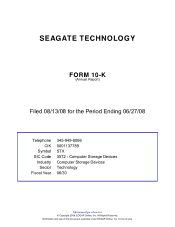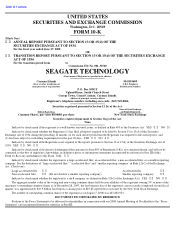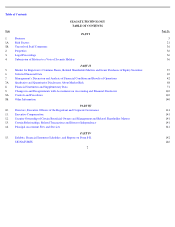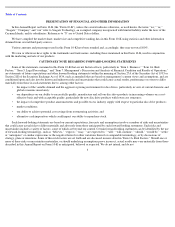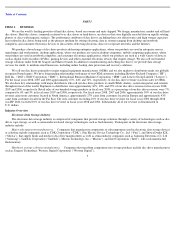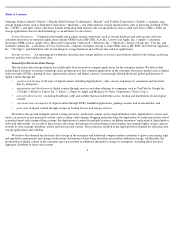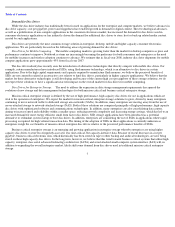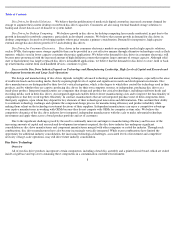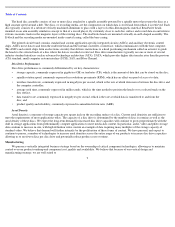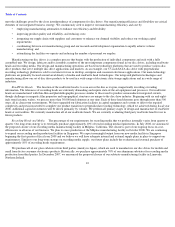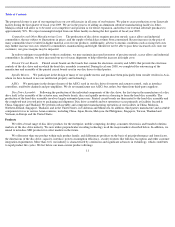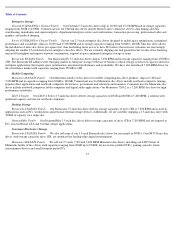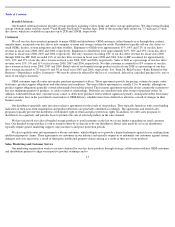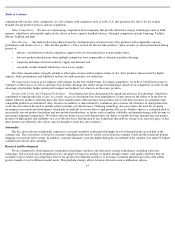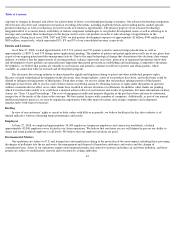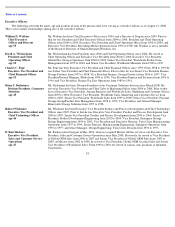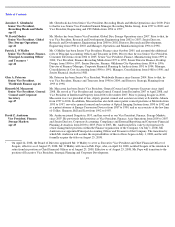Seagate 2007 Annual Report Download - page 10
Download and view the complete annual report
Please find page 10 of the 2007 Seagate annual report below. You can navigate through the pages in the report by either clicking on the pages listed below, or by using the keyword search tool below to find specific information within the annual report.
Table of Contents
The head disc assembly consists of one or more discs attached to a spindle assembly powered by a spindle motor that rotates the discs at a
high constant speed around a hub. The discs, or recording media, are the components on which data is stored and from which it is retrieved. Each
disc typically consists of a substrate of finely machined aluminum or glass with a layer of a thin-film magnetic material. Read/write heads,
mounted on an arm assembly similar in concept to that of a record player, fly extremely close to each disc surface and record data on and retrieve
it from concentric tracks in the magnetic layers of the rotating discs. The read/write heads are mounted vertically on an E-shaped assembly. The
E-block and the recording media are mounted inside a metal casing, called the base casing.
The printed circuit board contains standard and custom application specific integrated circuits (ASICs) and ancillary electronic control
chips. ASICs move data to and from the read/write head and the internal controller, or interface, which communicates with the host computer.
The ASICs and control chips form an electronic circuitry that delivers instructions to a head positioning mechanism called an actuator to guide
the heads to the selected track of a disc where the data is recorded or retrieved. Disc drive manufacturers typically use one or more of several
industry standard interfaces such as advanced technology architecture (ATA); SATA, which provides higher data transfer rates than the previous
ATA standard; small computer system interface (SCSI); SAS; and Fibre Channel.
Disc Drive Performance
Disc drive performance is commonly differentiated by six key characteristics:
•
storage capacity, commonly expressed in gigabytes (GB) or terabytes (TB), which is the amount of data that can be stored on the disc;
•
spindle rotation speed, commonly expressed in revolutions per minute (RPM), which has an effect on speed of access to data;
•
interface transfer rate, commonly expressed in megabytes per second, which is the rate at which data moves between the disc drive and
the computer controller;
•
average seek time, commonly expressed in milliseconds, which is the time needed to position the heads over a selected track on the
disc surface,
•
data transfer rate, commonly expressed in megabytes per second, which is the rate at which data is transferred to and from the
disc; and
Areal Density
•
product quality and reliability, commonly expressed in annualized return rates (ARR).
Areal density is a measure of storage capacity per square inch on the recording surface of a disc. Current areal densities are sufficient to
meet the requirements of most applications today. The capacity of a disc drive is determined by the number of discs it contains as well as the
areal density of these discs. We expect the long-term demand for increased disc drive capacities will continue to grow proportionately with the
shift in storage applications from predominantly compute applications to more media-rich content. In particular, audio, video and photo storage
data continue to increase in size, with high definition video content an example of data requiring many multiples of the storage capacity of
standard video. We believe that demand will further intensify by the proliferation of these forms of content. We have pursued, and expect to
continue to pursue, a number of technologies to increase areal densities across the entire range of our products to increase disc drive capacities
allowing us to use fewer discs per disc drive and potentially reduce product costs overtime.
Manufacturing
We pursue a vertically integrated business strategy based on the ownership of critical component technologies, allowing us to maintain
control over our product roadmap and component cost, quality and availability. We believe that because of our vertical design and
manufacturing strategy, we are well suited to
9

